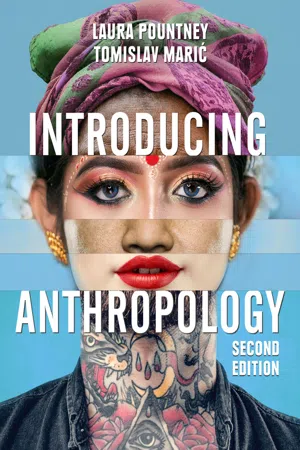
- English
- ePUB (mobile friendly)
- Available on iOS & Android
About this book
The perfect starting point for any student new to this fascinating subject, offering a serious yet accessible introduction to anthropology.
Across a series of fourteen chapters, Introducing Anthropology addresses the different fields and approaches within anthropology, covers an extensive range of themes and emphasizes the active role and promise of anthropology in the world today. The new edition foregrounds in particular the need for anthropology in understanding and addressing today's environmental crisis, as well as the exciting developments of digital anthropology.
This book has been designed by two authors with a passion for teaching and a commitment to communicating the excitement of anthropology to newcomers. Each chapter includes clear explanations of classic and contemporary anthropological research and connects anthropological theories to real-life issues at the local and global levels. The vibrancy and importance of anthropology is a core focus of the book, with numerous interviews with key anthropologists about their work and the discipline as a whole, and plenty of ethnographic studies to consider and use as inspiration for readers' own personal investigations. A clear glossary, a range of activities and discussion points, and carefully selected further reading and suggested ethnographic films further support and extend students' learning.
Introducing Anthropology aims to inspire and enthuse a new generation of anthropologists. It is suitable for a range of different readers, from students studying the subject at school-level to university students looking for a clear and engaging entry point into anthropology.
Frequently asked questions
- Essential is ideal for learners and professionals who enjoy exploring a wide range of subjects. Access the Essential Library with 800,000+ trusted titles and best-sellers across business, personal growth, and the humanities. Includes unlimited reading time and Standard Read Aloud voice.
- Complete: Perfect for advanced learners and researchers needing full, unrestricted access. Unlock 1.4M+ books across hundreds of subjects, including academic and specialized titles. The Complete Plan also includes advanced features like Premium Read Aloud and Research Assistant.
Please note we cannot support devices running on iOS 13 and Android 7 or earlier. Learn more about using the app.
Information
CHAPTER 1
What Makes Us Human?
Contents
- Key issues and debates
- How Did Humans Evolve?
- Explanations of human evolution
- Early humans
- Climate change, human evolution and the Anthropocene
- Where did modern humans originate from?
- Similarities and differences between humans and nonhuman primates
- Cultural Evolution
- Cooking
- Language
- Symbols
- Recording information: The origins of written language
- Social life
- Sharing resources, exchange
- Rituals.
- Expressing identity
- How Do Humans Vary? The Concept of Race and a Critique of the Concept
- Biological differences between humans
- Culturally constructed concepts of race
- American Association of Physical Anthropologists’ Statement on Race and Racism (2019)
- Conclusion
- End-of-chapter questions
- Key terms
- Personal investigation
- Suggested further sources
Key issues and debates
- How and when did Homo sapiens evolve?
- How similar are humans to other animals and in what ways are they different?
- What methods do we use to find out about early humans?
- How did different groups of early humans interact and what can this tell us about humans today?
- What impact has humanity’s specific biological evolution had in terms of shaping our cultural evolution: what is the relationship between human biology and culture?
- To what extent do humans vary?
How Did Humans Evolve?
- How are human origins explained?
- How do different groups explain the existence of dinosaurs and other extinct animals?
Explanations of human evolution
Creationism and evolution
Table of contents
- Cover
- Dedication
- Title Page
- Copyright
- Preface
- Acknowledgements
- 1 What Makes Us Human?
- 2 Research Methods
- 3 The Body
- 4 Ways of Thinking and Communicating
- 5 Social Relations
- 6 Engaging with Nature
- 7 Personhood
- 8 Identity
- 9 Ritual
- 10 Gender
- 11 Boundaries
- 12 Globalization
- 13 The Role of Material Culture
- 14 Applied Anthropology
- Key Terms
- References
- Ethnographic Films
- Websites
- Index
- End User License Agreement